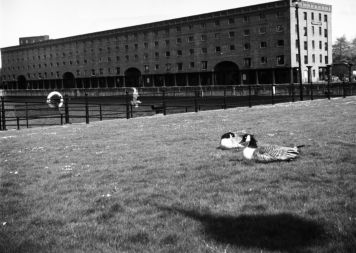News from 2018 OARSI World Congress in Liverpool
There is a huge number of over 600 million people worldwide suffering from osteoarthritis. Chronic pain and joint stiffness lead to severe decrease in quality of life or even disability. That’s why members of The Osteoarthritis Research Society International (OARSI) gather each year to discuss newest results regarding osteoarthritis management. This year OARSI meeting was held in Liverpool, UK and our PhD student, Kuba, went there in order to catch up on the recent advancements in osteoarthritis research. Conference offers a great place to meet and exchange experiences for scientists and health care professionals with an aim to prevent and treat osteoarthritis through the promotion and presentation of research, education and the worldwide dissemination of new knowledge.
Conference started with a session dedicated to brief discussion over recent OARSI white paper. “Osteoarthritis: A Serious Disease” is a huge publication created by a group of specialists, in which they make a strong justification for OA as a deliberating condition causing significant social burden. The aim of the paper is to attract genuine attention of the health service organizations such as FDA on importance of OA research. Speakers explained the content of the white paper and highlighted most profound findings of our research in the field. That was a great way to warm-up before following 3 days of rich programme. From our perspective, it was emphasized that current therapies have small effects but serious side-effects. For example, more than a half of patients is not satisfied with effects of joint replacement surgergy and more than o 25% of OA patients will suffer eventually from gastric ulcers as a result of NSAID treatment. What’s more, a high percentage of comorbities highly limits available pharmacological interventions. The most unfortunate fact is that the disease-modyfing osteoarthritis drugs (DMOADs) are still not available and this is something we’re trying to change.
The next session was made up of highest reated abstracts by Young Investigators. The title itself implies a great scientific value of the talks. Most of the speakers were focused on basic science and particular molecular approaches. The session started with a presentation about the influence of high-fat diet upon OA prevalence. The study examined effects of saturated fatty acids upon cartilage health and OA development with wide variety of techniques, both in vivo and in vitro. Next presentation was focused on novel popular target in OA research – Indian hedgehog (IHH) – a protein involved in chondrocyte differentiation, proliferation and maturation especially during endochondral ossification. A group of Japanese scientists showed that IHH is activated by chondrocyte specific protein – SOX9 and that IHH deletion attenuates chondrocyte degeneration. Following talks focused on immunological aspects of OA. American scientists from San Diego discussed link between aging, mitochondrial dysfunction and OA development through CD38 marker functioning, whereas another group from Rochester University described B-cell and macrophage infiltration as a candidate mechanism In pathogenesis in the OA of obesity. Another interesting finding was made by scientists from University of Nottingham, who showed that brain-neurotrophic factor (BDNF), which can be found in synovial fluid, is produced by synovial-like fibroblast and its levels are correlated with chronic pain in two animal models of OA.
A poster session was made up by an enormous number of over 800 posters of great scientific value. One of which was Kuba’s poster entitled: “DIFFERENTIAL REGULATION OF MATRIX METALLOPROTEINASES BY ANANDAMIDE AND 2-ARACHIDONOYLGLYCEROL IN HUMAN OSTEOARTHRITIC CHONDROCYTES”. Despite giving a short walkthrough his poster for others, Kuba took a chance to have a direct conversation with fellow scientists about their results and took a closer look at different results containing histological stainings in order to optimize this method in our lab. Now, only one moth apart from OARSI meeting, we can say, he made significant progression in this area and soon cartilage staining will add to our data. .
As you can see, OARSI2018 was overloaded with significant contributions to OA research. Even though, Kuba managed to find some time in between the sessions to wander around beautiful city of Liverpool to capture some of its amazing architecture. Enjoy Kuba’s reportage beneath the post!














